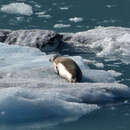Diagnostic Description
provided by FAO species catalogs
The taxonomy of the harbour seal is controversial, but most workers refer to 4 or 5 subspecies (described below). The body is plump and the head is small and cat-like, with a slight forehead. The nostrils are small and terminal, forming a "V" that converges at the bottom. The eyes are relatively large and set close together. The external ear openings are relatively large and conspicuous, and are set slightly behind and below the eyes. Prominent, light-coloured, beaded vibrissae are characteristic of harbour seals. harbour seals are not obviously sexually dimorphic, and it is extremely difficult to tell the sexes apart. The flippers are relatively short, only about one-fifth to one-sixth of standard length; they have long, thin, hooked claws on all digits. The ends of the foreflippers are somewhat squared off. The most conspicuous feature of the variably coloured coat is the presence of many fine spots, ring-like markings, and some blotches. The markings are usually scattered liberally over the body, but with fewer below than above. The most common base pattern is a light to dark grey or brown back, lightening to a paler belly (although some animals are uniformly coloured). In some localities, a few animals have a rust-coloured tinge, primarily on the head and upper body. Pups usually shed their silvery grey lanugo in the uterus (others may retain this lanugo for several weeks after birth). The dental formula is I 3/2, C 1/1, PC 5/5. Can be confused with: Eight other phocids share the range with 1 or more subspecies of harbour seal, presenting one of the most challenging identification problems among the pinnipeds. Features for distinguishing harbour seals from northern elephant seal, grey seal, and hooded seal are given in their respective species accounts. In the North Pacific, the Larga seal poses the most difficult identification problem. Details of the colour pattern provide the best clues for distinguishing them from the 2 Pacific subspecies of harbour seal. However, it should be noted that separating harbour and Larga seals may not always be possible.
- bibliographic citation
- Marine mammals of the world. Jefferson, T.A., S. Leatherwood & M.A. Webber - 1993. FAO species identification guide. Rome, FAO. 320 p. 587 figs. .
- author
- Food and Agriculture Organization of the UN
Size
provided by FAO species catalogs
Adult males are up to 1.9 m long and weigh 70 to 150 kg, females 1.7 m and 60 to 110 kg. At birth, pups are 65 to 100 cm and 8 to 12 kg.
- bibliographic citation
- Marine mammals of the world. Jefferson, T.A., S. Leatherwood & M.A. Webber - 1993. FAO species identification guide. Rome, FAO. 320 p. 587 figs. .
- author
- Food and Agriculture Organization of the UN
Brief Summary
provided by FAO species catalogs
On land, harbour seals are usually extremely wary and shy. It is almost impossible to approach them closely without frightening them into the water. They are gregarious at haul-out sites, where they frequently aggregate, especially at low tide. However, despite this aggregation behaviour, adults usually do not lie in close contact with each other. At sea, they are most often seen alone or in small groups. The mating system is promiscuous or weakly polygynous. Mating usually takes place in the water, during the February to October breeding season. Pupping peaks sometime between April and July. In some regions, pupping occurs earlier in more southerly areas. Harbour seals feed on a wide variety of fish, cephalopods, and crustaceans of surface, mid-water, and benthic habitats.
- bibliographic citation
- Marine mammals of the world. Jefferson, T.A., S. Leatherwood & M.A. Webber - 1993. FAO species identification guide. Rome, FAO. 320 p. 587 figs. .
- author
- Food and Agriculture Organization of the UN
Benefits
provided by FAO species catalogs
Conservation Status : Harbour seals have been hunted for food since prehistoric times. They have been taken for pelts in small local enterprises and large commercial operations, and under quota and bounty systems as threats to the fishing industry. Most recently, an outbreak of a distemper virus claimed an estimated 18 000 seals in the European population. Also, due to the proximity of these seals to centres of human industrial dumping and agricultural runoff, many carry high burdens of toxic pollutants, whose effects on seal health and reproduction is undetermined. Small-scale subsistence harvesting, poaching, and incidental catch in fishing gear, particularly in gillnets, account for an unknown level of annual mortality. IUCN: Insufficiently known; Vulnerable (P.v.stejnegeri only).
- bibliographic citation
- Marine mammals of the world. Jefferson, T.A., S. Leatherwood & M.A. Webber - 1993. FAO species identification guide. Rome, FAO. 320 p. 587 figs. .
- author
- Food and Agriculture Organization of the UN

